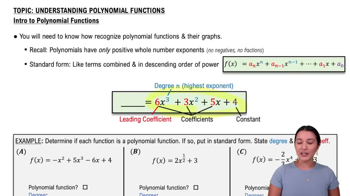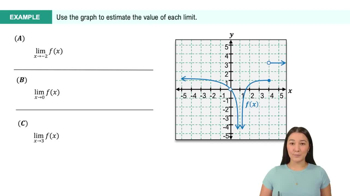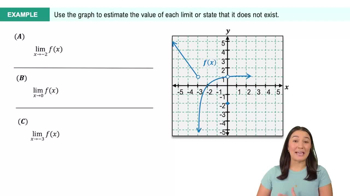Table of contents
- 0. Functions7h 52m
- Introduction to Functions16m
- Piecewise Functions10m
- Properties of Functions9m
- Common Functions1h 8m
- Transformations5m
- Combining Functions27m
- Exponent rules32m
- Exponential Functions28m
- Logarithmic Functions24m
- Properties of Logarithms34m
- Exponential & Logarithmic Equations35m
- Introduction to Trigonometric Functions38m
- Graphs of Trigonometric Functions44m
- Trigonometric Identities47m
- Inverse Trigonometric Functions48m
- 1. Limits and Continuity2h 2m
- 2. Intro to Derivatives1h 33m
- 3. Techniques of Differentiation3h 18m
- 4. Applications of Derivatives2h 38m
- 5. Graphical Applications of Derivatives6h 2m
- 6. Derivatives of Inverse, Exponential, & Logarithmic Functions2h 37m
- 7. Antiderivatives & Indefinite Integrals1h 26m
- 8. Definite Integrals4h 44m
- 9. Graphical Applications of Integrals2h 27m
- 10. Physics Applications of Integrals 2h 22m
1. Limits and Continuity
Introduction to Limits
Problem 2.4.56
Textbook Question
Find polynomials p and q such that f=p/q is undefined at 1 and 2, but f has a vertical asymptote only at 2. Sketch a graph of your function.
 Verified step by step guidance
Verified step by step guidance1
Step 1: Understand the problem requirements. We need to find polynomials p(x) and q(x) such that the rational function f(x) = \frac{p(x)}{q(x)} is undefined at x = 1 and x = 2, but has a vertical asymptote only at x = 2.
Step 2: Recall that a rational function is undefined where its denominator is zero. To make f(x) undefined at x = 1 and x = 2, q(x) should have factors (x - 1) and (x - 2).
Step 3: To ensure a vertical asymptote at x = 2, the factor (x - 2) should not be canceled out by the numerator p(x). Therefore, p(x) should not have the factor (x - 2).
Step 4: To make f(x) defined at x = 1, the factor (x - 1) in q(x) should be canceled by a similar factor in p(x). Thus, p(x) should have the factor (x - 1).
Step 5: Construct the polynomials. Let p(x) = (x - 1) and q(x) = (x - 1)(x - 2). This ensures f(x) = \frac{(x - 1)}{(x - 1)(x - 2)} is undefined at x = 1 and 2, but has a vertical asymptote only at x = 2.
 Verified video answer for a similar problem:
Verified video answer for a similar problem:This video solution was recommended by our tutors as helpful for the problem above
Video duration:
5mPlay a video:
Was this helpful?
Key Concepts
Here are the essential concepts you must grasp in order to answer the question correctly.
Polynomials
Polynomials are mathematical expressions consisting of variables raised to non-negative integer powers and coefficients. They can be represented in the form p(x) = a_n*x^n + a_(n-1)*x^(n-1) + ... + a_1*x + a_0, where a_n are constants and n is a non-negative integer. Understanding polynomials is crucial for constructing rational functions, as they form the numerator and denominator in the expression f = p/q.
Recommended video:

Introduction to Polynomial Functions
Vertical Asymptotes
Vertical asymptotes occur in rational functions when the denominator approaches zero while the numerator remains non-zero, leading to the function tending towards infinity. For the function f = p/q to have a vertical asymptote at x = 2, the polynomial q must have a factor (x - 2) that causes q(2) = 0, while p(2) must not equal zero. This concept is essential for determining the behavior of the function near specific points.
Recommended video:

Introduction to Cotangent Graph Example 1
Undefined Points
A function is undefined at points where its denominator equals zero, as division by zero is not permissible. In the context of the given question, the function f = p/q must be undefined at x = 1 and x = 2, meaning that q must have factors (x - 1) and (x - 2). However, to ensure a vertical asymptote only at x = 2, the factor (x - 1) must be canceled out in the numerator p, which influences the overall behavior of the function.
Recommended video:

Critical Points

 6:47m
6:47mWatch next
Master Finding Limits Numerically and Graphically with a bite sized video explanation from Callie
Start learning





